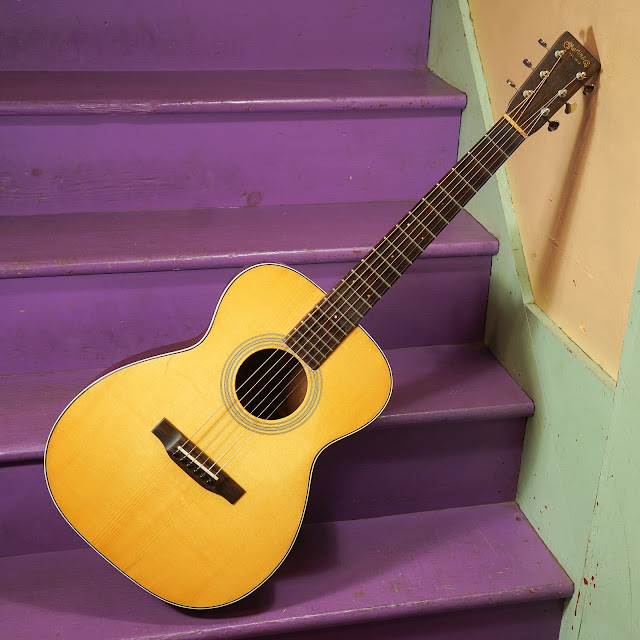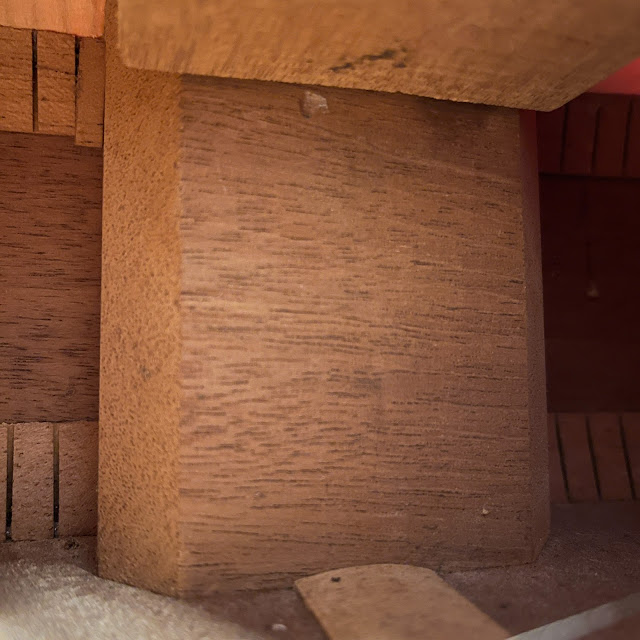1936 Martin R-17 Flattop Conversion (00-18) Guitar
Some time back, Mr. Joel Whitehead converted this 1936 Martin R-17 (archtop) body into a flattop guitar. I'm guessing this was an early conversion project of his. My consignor bought it and it languished here for ages until I could get-around to sprucing it up for him. Because it's converted to a flattop, this is basically a '30s Martin 00-18 body with a new top.
The top was described to the new owner as "Adirondack spruce" and "nitro-finished" but... I think it's possible the top is wide-grain Adi but the finish is definitely poly and has some finish-cracks in it (glassy-like) that have broken in a poly-style way. It also looks like it may have been reused from a different guitar project because under the fretboard extension the top is fit and cut for a modern-style truss rod with a plugged hole through the top brace (under the fretboard access at the soundhole). There's also some disturbed finish around the fretboard extension which suggests a different fretboard was on this top in the past. The top itself is x-braced in a more vintage, forward-shifted pattern and the braces have been shaved-down to approximate scalloped '30s bracing.
There were quite a number of setup-side issues that needed to be dealt with before this became a good player, but now that it's fixed-up, it's playing nicely and is good to go. There are some definite quirks with this guitar, but it's a rewarding, offbeat instrument and a nice way to get some of that '30s 00-size feel and sound without having to refinance your house.
Repairs included: fretboard extension reglue, fret seating, fret level/dress, fill of saddle slot and reposition/recut of it, new bone saddle, fill/redrill of pinholes at the bridge, seam repairs, and setup-side work.
Top wood: solid spruce
Back & sides wood: solid mahogany
Bracing type: x, scalloped
Bridge: rosewood family
Fretboard: rosewood
Neck wood: mahogany
Action height at 12th fret: 3/32” bass 1/16” treble (fast, spot-on)
String gauges: 54w, 40w, 30w, 22w, 16, 12
Neck shape: medium C/soft V
Board radius: ~12-14
Truss rod: non-djustable
Neck relief: straight on bass side, hair of relief treble side
Fret style: medium low
Scale length: 24 3/4"
Nut width: 1 3/4"
Body width: 14 5/8"
Body depth: 4 1/4"
Weight: 3 lbs 10 oz
Condition notes: top is replaced but the back, sides, neck, and fretboard are original '30s Martin. The neckblock looks like it's either replaced or was not serialized by Martin. The finish on the neck looks like it might be oversprayed/buffed but the back and sides look refinished. There are no cracks in the top but there are finish cracks in the top. The back has a couple of repaired hairline cracks. The treble side has one small punch-in crack repair at the waist. The top was glued over a not-quite-flat edge and so there's a little distortion in the top's outer edges around the waist area. The new binding on the top was not installed cleanly and it overhangs the sides just slightly here and there along the top edge. There are also a few minor gaps here and there in the layers of binding and the top itself. There's general wear and tear to the finish throughout the guitar but the most surprising is that along the top's edges there's muck in the finish and minor scratching/scuffing. I've taken a few "glared" shots to give an idea of it.
More notes: the bridge was installed in the wrong place (1/4" off from proper compensation of the saddle) and so I've filled and relocated the saddle slot and cut a new saddle. My alignment on the saddle with the pins is slightly "off" favoring the treble side because when I cut the new slot I set it for the middle of the bridge and not the actual string path the neck was reset at before me. Oops! It's not obvious unless you're looking carefully. The pinholes were filled and redrilled as well. I've included some photos right after doing that of the bracing inside so you can get an idea of what it looks like in there. Please excuse the drilling-mess!
Yet more notes: the tuners are replaced (with nice 18:1 Grover Sta-Tites). Also, there's disturbance to the top finish at the end of the fretboard, as if this was a top salvaged from another guitar with another board installed.






























Comments